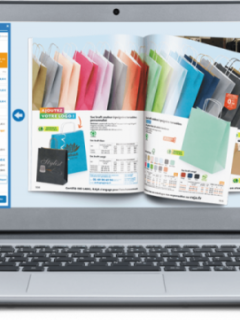Next to the computer and pencil, paper is the most used working tool in the office. And there’s no such thing as paper – each has different properties, which are listed in the following guide.
WHITE LEVEL
Whiteness grade is a measured value for the “whiteness” of an object, in this case paper. Because the human eye perceives different shades of white, these values are calculated based on standard measurement procedures and standardized conditions , such as: the lighting of the paper. The designation CIE – Commission Internationale de l’Éclairage (“International Commission on Illumination”) deals extensively with colour and works with well-known organisations such as ISO (International Organisation for Standardisation) in the field of standardisation. The higher the measured value, the higher the degree of whiteness of the paper. For paper used in offices, this value is approximately 160. A high degree of whiteness gives a very valuable impression, and colour printing shows a clear and strong expression.
GRAMAGE
Thegrammage is an indicator of the quality of the paper and describes the weight, i.e. the weight in relation to the surface area of the material. Accordingly, it is stated in grams per square metre (g/m², g/qm or gqm). Standard copy paper usually has a basis weight of 80 g/m². In this case we are talking about 80g paper. Too low a grammage causes the paper to bend and tear and is also not suitable for double-sided printing, which would show through heavily. The grammage also affects the weight of the paper and so can affect postage costs. In an attempt to save on postage costs, letters are often printed on lower weight paper.
OPACITA
Theopacity of office paper plays an important role for double-sided printing. Opacity is the opposite of transparency and describes the property of not transmitting light rays. Opacity is expressed as a percentage from 0 (completely transparent) to 100% (completely opaque). Paper to be printed on both sides is required to be at least 80% opacity. If the opacity of the paper is low, the print on the reverse side will show through and be illegible.
PAPER THICKNESS
Paper thickness describes the thickness in mm or microns. Paper used in offices is usually 0.1 mm thick. The difference is not visible to the naked eye. Of course, the higher the thickness of the paper, the higher the quality and opacity.
DIN FORMAT
DIN formats are the most common paper sheet size specifications. They were developed by the German Institute for Standardization (DIN) and later standardized in almost all countries (exceptions are, for example, North American countries). In everyday life, common formats are, for example, DIN A2 ( 420 x 594 mm for posters), DIN A4 (210 x 297 mm for letters) or DIN A6 (105 x 148 mm for leaflets). For office copies, A4 paper is usually required, or A3 for larger prints.
MULTIFUNCTIONALITY
Theuniversal (or also multifunctional) designation of a paper means that it is suitablefor everyday general use and also suitable for all office machines. The surface of the paper is adapted to hold inkjet and laser printer ink well and dry quickly. It is also a versatile paper suitable for copying and faxing. In contrast, specialty paper is designed only for a specific purpose. For example, photographic paper has a glossy surface and is therefore unsuitable for business correspondence.














